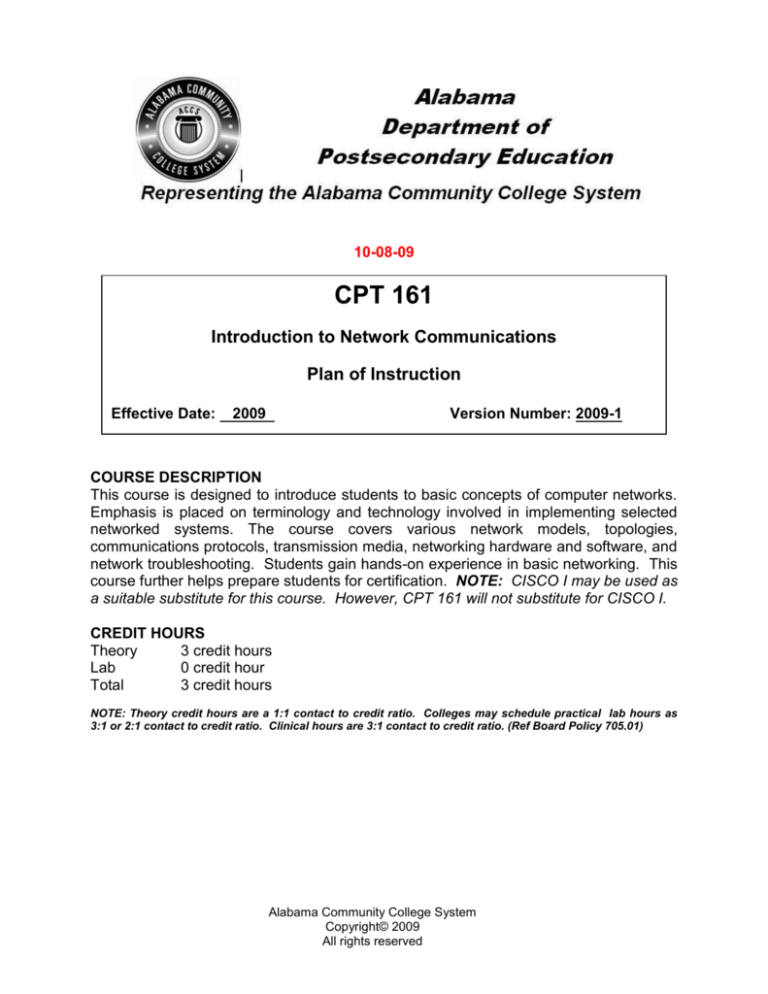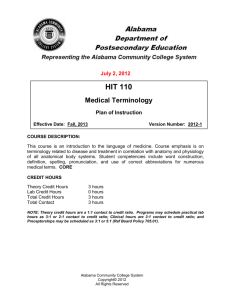
10-08-09
CPT 161
Introduction to Network Communications
Plan of Instruction
Effective Date:
2009
Version Number: 2009-1
COURSE DESCRIPTION
This course is designed to introduce students to basic concepts of computer networks.
Emphasis is placed on terminology and technology involved in implementing selected
networked systems. The course covers various network models, topologies,
communications protocols, transmission media, networking hardware and software, and
network troubleshooting. Students gain hands-on experience in basic networking. This
course further helps prepare students for certification. NOTE: CISCO I may be used as
a suitable substitute for this course. However, CPT 161 will not substitute for CISCO I.
CREDIT HOURS
Theory
3 credit hours
Lab
0 credit hour
Total
3 credit hours
NOTE: Theory credit hours are a 1:1 contact to credit ratio. Colleges may schedule practical lab hours as
3:1 or 2:1 contact to credit ratio. Clinical hours are 3:1 contact to credit ratio. (Ref Board Policy 705.01)
Alabama Community College System
Copyright© 2009
All rights reserved
Introduction to Network Communications
CPT 161
PREREQUISITE COURSES
Determined by college unless stated otherwise
CO-REQUISITE COURSES
Determined by college unless stated otherwise
PROFESSIONAL COMPETENCIES:
Explain basic concepts related to networking.
Install, configure, and troubleshoot network hardware.
Install and configure network operating systems.
INSTRUCTIONAL GOALS
Cognitive: Comprehend foundational knowledge of computer network systems.
Psychomotor: Apply foundational knowledge of computer
encountered in a classroom simulated workplace environment.
network
systems
Affective: There are no affective goals directly associated with this course.
STUDENT OBJECTIVES:
Condition Statement: Unless otherwise indicated, evaluation of student’s attainment
of objectives is based on knowledge gained from this course. Specifications may be in
the form of, but not limited to, cognitive skills diagnostic instruments, manufacturer’s
specifications, technical orders, regulations, national and state codes, certification
agencies, locally developed lab/clinical assignments, or any combination of
specifications.
ACCS Copyright© 2009
All rights reserved
2
Introduction to Network Communications
CPT 161
MODULE A – NETWORKING PRINCIPLES
PROFESSIONAL COMPETENCIES
A1.0 Explain basic concepts related to
networking.
PERFORMANCE OBJECTIVES
A1.1 This module is measured
cognitively.
KSA
2
LEARNING OBJECTIVES
A1.1.1 Define terms associated with networking.
A1.1.2 Explain concepts associated with networking.
A1.1.3 Identify types of certifications available for networking.
A1.1.4 Explain the procedures for obtaining various network certifications.
A1.1.5 Identify the components of a network.
A1.1.6 Explain network standards.
A1.1.7 Explain the OSI model.
A1.1.8 Explain network protocols.
A1.1.9 Explain network topologies.
MODULE A OUTLINE:
Networking terms and concepts
Network certifications
Network components
Network standards
OSI model
Network protocols
Network topologies
1
2
1
2
1
2
2
2
2
ACCS Copyright© 2009
All rights reserved
3
Introduction to Network Communications
CPT 161
MODULE B – NETWORKING TECHNOLOGY
PROFESSIONAL COMPETENCIES
B1.0 Install, configure, and
troubleshoot network hardware.
PERFORMANCE OBJECTIVES
B1.1 Given materials and
specifications install and
troubleshoot a network.
KSA
Indicators
2
LEARNING OBJECTIVES
B1.1.1
B1.1.2
B1.1.3
B1.1.4
B1.1.5
Explain characteristics of the types of connectivity.
Explain tools used for installing network equipment and components.
Explain networking media.
Explain the process of constructing cable.
Summarize the process of installing and configuring network
hardware.
B1.1.6 Explain the process of troubleshooting a network.
B1.1.7 Explain the process of verifying connectivity.
B1.1.8 Explain the process of performing preventative maintenance.
B1.1.9 Explain when to upgrade or replace network components.
B1.1.10 Explain developing a baseline and monitoring network performance.
MODULE B OUTLINE:
Characteristics of connectivity
Tools and Support equipment
Networking media
Hardware installation and configuration
Device drivers
Wired
Wireless
Troubleshooting network hardware and connectivity
Resources
Processes
Documentation
Preventive maintenance
Monitoring performance
ACCS Copyright© 2009
All rights reserved
2
1
2
2
2
2
2
2
2
2
4
Introduction to Network Communications
CPT 161
MODULE C – NETWORK OPERATING SYSTEMS
PROFESSIONAL COMPETENCIES
C1.0 Install and configure network
operating systems.
PERFORMANCE OBJECTIVES
C1.1 Given materials and
specifications install and
configure a network operating
system.
KSA
Indicators
2
LEARNING OBJECTIVES
C1.1.1
C1.1.2
C1.1.3
C1.1.4
Explain the primary functions of a network operating system.
Explain installing and configuring a network operating system.
Explain basic concepts of network administration.
Explain basic concepts of troubleshooting a network operating
system.
MODULE C OUTLINE:
Functions of network operating systems
Installing and configuring network operating systems
Network Administration
Creating resource shares
Creating accounts.
Ensuring network security
Basic network operating system troubleshooting
Resources
Documentation
ACCS Copyright© 2009
All rights reserved
2
2
2
2
5
Introduction to Network Communications
CPT 161
LEARNING OUTCOMES TABLE OF SPECIFICATIONS
The table below identifies the percentage of learning objectives for each module.
Instructors should develop sufficient numbers of test items at the appropriate
level of evaluation.
1
Moderate
Knowledge
and
Proficiency
2
Advanced
Knowledge
and
Proficiency
3
Superior
Knowledge
and
Proficiency
4
33%
10%
-
66%
90%
100%
-
-
Limited
Knowledge and
Proficiency
Module A
Module B
Module C
Indicator
1
2
3
4
Learner’s Knowledge, Skills and Abilities
Key Terms
Description
Identifies basic facts and terms about the subject or
competency.
Limited
Knowledge Performs simple tasks associated with the
and
competency. Needs to be told or shown how to do
Proficiency
most tasks.
Requires close supervision.
Identifies relationship of basic facts and states
general principles and can determine step-by-step
Moderate
procedures for doing the competency.
Knowledge
and
Performs most parts of the competency. Needs help
Proficiency
only on hardest parts.
Requires limited supervision.
Analyzes facts and principles and draws conclusions
about the subject to include why and when the
Advanced
competency must be done and why each step is
Knowledge
needed. Can predict outcomes.
and
Performs all parts of the competency. Needs only a
Proficiency
spot check of completed work.
Requires little or no direct supervision.
Can evaluate conditions and make appropriate
Superior
decisions as related to resolving problems.
Knowledge
Performs competency quickly and accurately with no
and
direct supervision and is able to instruct and
Proficiency
supervise others.
ACCS Copyright© 2009
All rights reserved
6




